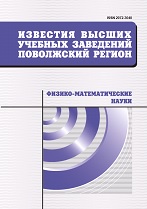|
Physics
Photoinduced modulation of the dielectric permittivity in a system of interacting quantum dots in an external electric field
V. D. Krevchik, A. V. Razumov, M. B. Semenov
Penza State University, Penza
Abstract:
Background. At present, much attention is paid to the dielectric engineering of the material of the surrounding matrix and low-dimensional structures, which makes it possible to purposefully change their properties and optimize the characteristics of semiconductor devices. The purpose of this work is a theoretical study of the influence of the pair interacting quantum dots (QDs), as well as their interaction with the surrounding matrix through 2D - dissipative tunneling, on the photodielectric effect (PDE) associated with the excitation of an impurity complex (А$^+$ + е) in a QD system in an external electric field. Materials and methods. Interaction of an electron with a hole in an impurity complex (А$^+$ + е) in a QD has been considered in the adiabatic approximation. The dispersion equations for a hole in an impurity complex (А$^+$ + е) in the presence of an external electric field and 2D- dissipative tunneling for the s - and p -states of an electron in a QD are obtained within the framework of the zero-range potential model in the effective mass approximation. The influence of the electric field on the ground state of an electron in a QD has been taken into account in the second order of the perturbation theory. The probability of 2D - dissipative tunneling is calculated in the one-instanton semiclassical approximation. The relative change in dielectric permittivity has been calculated in the dipole approximation. PDE field dependence curves have been plotted for InSb QDs. Results. It is shown that the PDE field dependence at a certain value of the strength of an external electric field and the parameters of 2D - dissipative tunneling has a characteristic kink associated with the effect of 2D - bifurcation, when under the action of an electric field the double-well oscillatory potential simulating the “QD - surrounding matrix” system is transformed and the tunnel transfer mode changes from synchronous to asynchronous. It has been established that there are irregular oscillations on the PDE curves in the vicinity of the 2D bifurcation point, which are associated with the regime of quantum beats. It is shown that the amplitude of the oscillations increases with increasing phonon mode frequency and temperature, and the break point shifts towards weaker fields. It has been found that an increase in the constant of interaction with the contact medium, as well as with the constant of the pair interaction of QDs, leads to the suppression of the PDE. Conclusions. The theoretically studied PDE at a wavelength of $\lambda$=6.2 $\mu$m in a QD with an impurity complex (А$^+$ + е) in the presence of interaction with the surrounding matrix through 2D - dissipative tunneling of a hole localized at the А$^+$-center can be used in photosensor applications, for example, as a sensor, the structural component of which can detect the presence of IR - radiation due to a change in electrical capacitance.
Keywords:
photodielectric effect, quantum dot, adiabatic approximation, impurity complex, relative dielectric permittivity, 2D dissipative tunneling, quantum beats, the electron adiabatic potential.
Citation:
V. D. Krevchik, A. V. Razumov, M. B. Semenov, “Photoinduced modulation of the dielectric permittivity in a system of interacting quantum dots in an external electric field”, University proceedings. Volga region. Physical and mathematical sciences, 2023, no. 2, 122–143
Linking options:
https://www.mathnet.ru/eng/ivpnz538 https://www.mathnet.ru/eng/ivpnz/y2023/i2/p122
|

| Statistics & downloads: |
| Abstract page: | 34 | | Full-text PDF : | 10 | | References: | 7 |
|




 Contact us:
Contact us: Terms of Use
Terms of Use
 Registration to the website
Registration to the website Logotypes
Logotypes







 Citation in format
Citation in format 